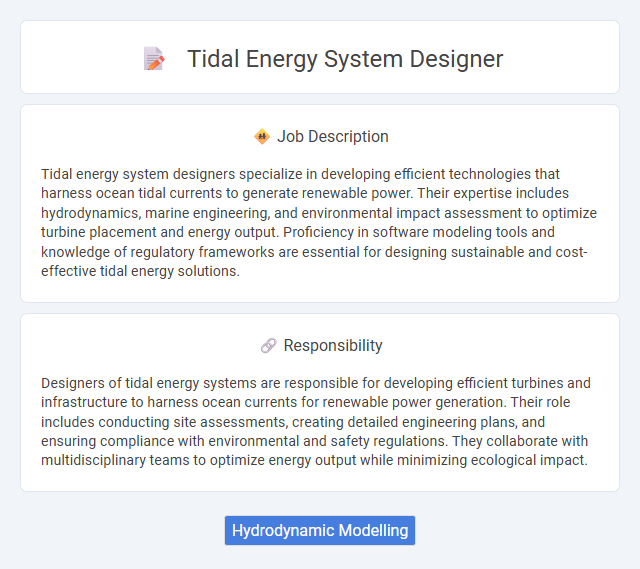
Tidal energy system designers specialize in developing efficient technologies that harness ocean tidal currents to generate renewable power. Their expertise includes hydrodynamics, marine engineering, and environmental impact assessment to optimize turbine placement and energy output. Proficiency in software modeling tools and knowledge of regulatory frameworks are essential for designing sustainable and cost-effective tidal energy solutions.
Individuals with a strong passion for renewable energy and a background in marine engineering or environmental science are likely to be well-suited for a tidal energy system designer role. Those who are comfortable working in interdisciplinary teams and adapting to rapidly evolving technologies may find this career fulfilling. Candidates with a tolerance for challenging offshore conditions and a willingness to engage in continuous learning could have higher chances of success in this field.
Qualification
A tidal energy system designer must possess a strong background in marine engineering, renewable energy technologies, and fluid dynamics. Proficiency in computer-aided design (CAD) software and experience with tidal turbine prototypes are essential qualifications. Advanced degrees in engineering or environmental science coupled with knowledge of energy storage and grid integration enhance a candidate's expertise in tidal energy system design.
Responsibility
Designers of tidal energy systems are responsible for developing efficient turbines and infrastructure to harness ocean currents for renewable power generation. Their role includes conducting site assessments, creating detailed engineering plans, and ensuring compliance with environmental and safety regulations. They collaborate with multidisciplinary teams to optimize energy output while minimizing ecological impact.
Benefit
A tidal energy system designer likely benefits from contributing to sustainable energy solutions with high renewable potential due to predictable tidal patterns. The job probably offers opportunities for innovation in marine technology, enhancing efficiency and environmental impact. Career growth may be influenced by the increasing global demand for clean energy infrastructure.
Challenge
Designing tidal energy systems likely involves overcoming significant engineering challenges related to harsh marine environments and variable tidal patterns. The role probably requires innovative problem-solving to optimize energy capture while minimizing environmental impact and maintenance costs. Candidates might need to anticipate and address issues such as corrosion, biofouling, and structural integrity under extreme conditions.
Career Advancement
Tidal energy system designers specialize in developing innovative underwater turbine technologies to harness renewable ocean energy, improving energy efficiency and sustainability. Career advancement opportunities include roles such as senior engineer, project manager, or renewable energy consultant, often requiring expertise in fluid dynamics, marine engineering, and environmental impact assessment. Professionals can further enhance their career by obtaining advanced certifications and engaging in cross-disciplinary projects within the clean energy sector.
Key Terms
Hydrodynamic Modelling
Tidal energy system designers specializing in hydrodynamic modelling develop advanced simulations to predict tidal flow patterns and optimize turbine placement for maximum energy extraction. Expertise in computational fluid dynamics (CFD), numerical wave modeling, and marine environment analysis is essential to accurately assess site-specific hydrodynamic conditions. Proficiency with software tools such as MIKE 21, ANSYS Fluent, and OpenFOAM facilitates the creation of reliable models that drive innovative design solutions in tidal power projects.
 kuljobs.com
kuljobs.com